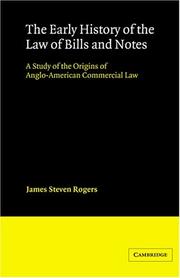| Listing 1 - 1 of 1 |
Sort by
|

ISBN: 0521522048 0521442125 0511470592 9780521442121 9780511470592 9780521522045 Year: 1995 Publisher: Cambridge : Cambridge university press,
Abstract | Keywords | Export | Availability | Bookmark
 Loading...
Loading...Choose an application
- Reference Manager
- EndNote
- RefWorks (Direct export to RefWorks)
This study traces the history of the law of bills and notes in England from medieval times to the period in the late eighteenth and early nineteenth centuries when bills played a central role in the domestic and international financial system. It challenges the traditional theory that English commercial law developed by incorporation of the concept of negotiability and other rules from an ancient body of customary law known as the law merchant. Rogers shows that the law of bills was developed within the common law system itself, in response to changing economic and business practices. This account draws on economic and business history to explain how bills were actually used and to examine the relationship between the law of bills and economic and social controversies.
History of the law --- Financial law --- Economic law --- United Kingdom --- Bills of exchange --- 34 <09> <41> --- Rechtsgeschiedenis --(algemeen)--Verenigd Koninkrijk van Groot-Brittannië en Noord-Ierland --- 34 <09> <41> Rechtsgeschiedenis --(algemeen)--Verenigd Koninkrijk van Groot-Brittannië en Noord-Ierland --- -Bills of exchange --- -Negotiable instruments --- -346.0960941 --- Ea1.igbr --- Exchange, Bills of --- Discount houses (Finance) --- Negotiable instruments --- 346.0960941 --- Bills and notes --- Bills of credit --- Commercial paper --- Credit, Bills of --- Credit, Titles of --- Instruments, Negotiable --- Negotiable notes --- Negotiable paper --- Titles of credit --- Choses in action --- Commercial documents --- Commercial law --- Legal instruments --- Drafts --- Financial instruments --- Acceptances --- History --- Law and legislation --- 336.7 <09> --- 336.7 <09> Geschiedenis van het bankwezen --- Geschiedenis van het bankwezen --- History. --- Arts and Humanities --- Negotiable instruments - Great Britain - History. --- Bills of exchange - Great Britain - History.
| Listing 1 - 1 of 1 |
Sort by
|

 Search
Search Feedback
Feedback About UniCat
About UniCat  Help
Help News
News